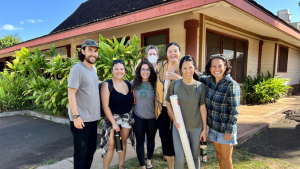
Fresh water in West Maui has been mismanaged for more than 180 years, according to many kamaʻāina, Native Hawaiians and community activists, in an issue that has received international attention in the wake of the deadly wildfire that destroyed Lahaina town.
The area from Ukumehame to Honokōhau, known as Maui Komohana, that includes Lahaina, was once flourishing with fresh waterways, loʻi kalo terraces, fishponds, and fields of ʻulu (breadfruit) and ʻuala (sweet potato). Beginning in the mid-19th century, water was diverted for commercial agriculture and eventually to resort hotels, leaving Maui Komohana with insufficient water to cultivate traditional crops and support subsistence lifestyles.

Since 2021, the University of Hawaiʻi at Mānoa William S. Richardson School of Law has been assisting Maui Komohana residents in reclaiming their water rights, in a community project through the law school’s Ka Huli Ao Center for Excellence in Native Hawaiian Law that is also providing law students with invaluable real world experience.
“There’s an implicit culture in law that says lawyers are the experts. I think the clinic really helped me understand that the experts are the folks in the community,” said Troy Ballard, who first participated as a law school student and is now helping run the clinic as a Post Juris Doctor Fellow. “As lawyers we are meant to serve and co-power and uplift, and this clinic was a unique opportunity to be able to work with experts in the community. I will be forever grateful for the relationships I have built through this opportunity.”
The situation with the return of water rights was exacerbated by the devastating Lahaina fire. An emergency proclamation by Gov. Josh Green that suspended the Water Code, Hawaiʻi Revised Statutes chapter 174C, was lifted one month later. Ever since, the clinic has been back at work helping community members navigate the water use permitting process.

“These permits are vital in helping bring the law to life on the ground and in our communities,” said Kapua Sproat, a UH professor of law. “What we’ve seen in these communities is that even though the black letter law carries a certain weight, it hasn’t been respected or implemented or informed water allocations.”
UH law school faculty and students staffing the clinic were in Lahaina in the weeks before the wildfire that leveled the historic town. They met with community members at Waiola Church and were staying at the Nā ʻAikāne o Maui Cultural Center on Front Street. Both of those buildings, along with the vast majority of Lahaina, were destroyed on August 8.
“Nā ʻAikāne o Maui Cultural Center was a hub for the community and a waihona (repository) of priceless work, history and artifacts. Despite their own devastation, the Kapu ʻohana, who stewards that place, rose to serve their community. That is emblematic of the people of this place: selfless, hardworking, and full of aloha,” said Uʻilani Tanigawa Lum, a UH assistant professor of law and co-director of the Native Hawaiian Rights Clinic.
Seeing the devastation afterwards only strengthened the resolve of everyone involved with Ka Huli Ao Center in helping the multi-generational families who call Maui Komohana home.
“Against the backdrop of a storied history of displacement and mismanagement of water resources, these devastating fires continue to uncover larger and systemic injustices. We are grateful to have the privilege of working with this community because they are some of the most kūpaʻa (steadfast) and strong members who have been fighting this battle for generations,” said Tanigawa Lum.


